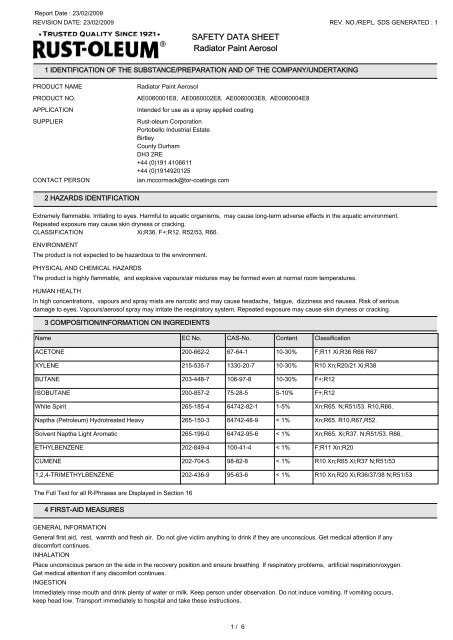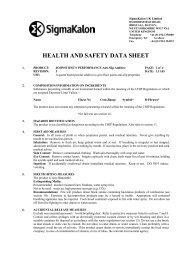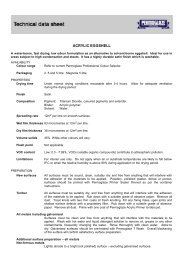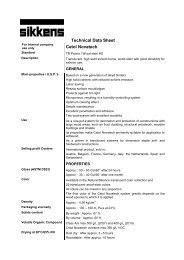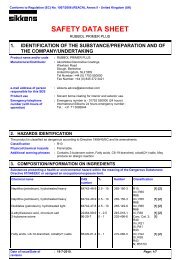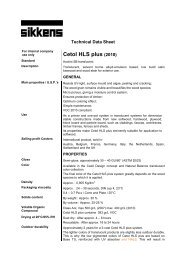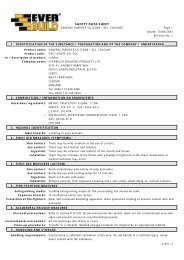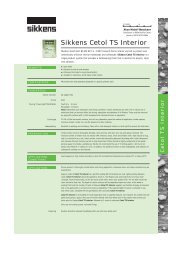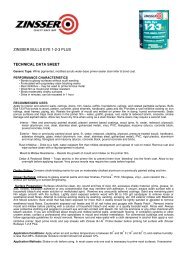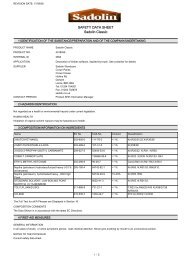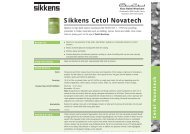Download .pdf - Rust-Oleum Spray Paint
Download .pdf - Rust-Oleum Spray Paint
Download .pdf - Rust-Oleum Spray Paint
- No tags were found...
Create successful ePaper yourself
Turn your PDF publications into a flip-book with our unique Google optimized e-Paper software.
Report Date : 23/02/2009<br />
REVISION DATE: 23/02/2009 REV. NO./REPL. SDS GENERATED : 1<br />
SAFETY DATA SHEET<br />
Radiator <strong>Paint</strong> Aerosol<br />
1 IDENTIFICATION OF THE SUBSTANCE/PREPARATION AND OF THE COMPANY/UNDERTAKING<br />
PRODUCT NAME<br />
PRODUCT NO.<br />
APPLICATION<br />
SUPPLIER<br />
CONTACT PERSON<br />
Radiator <strong>Paint</strong> Aerosol<br />
AE0060001E8, AE0060002E8, AE0060003E8, AE0060004E8<br />
Intended for use as a spray applied coating<br />
<strong>Rust</strong>-oleum Corporation<br />
Portobello Industrial Estate<br />
Birtley<br />
County Durham<br />
DH3 2RE<br />
+44 (0)191 4106611<br />
+44 (0)1914920125<br />
ian.mccormack@tor-coatings.com<br />
2 HAZARDS IDENTIFICATION<br />
Extremely flammable. Irritating to eyes. Harmful to aquatic organisms, may cause long-term adverse effects in the aquatic environment.<br />
Repeated exposure may cause skin dryness or cracking.<br />
CLASSIFICATION Xi;R36. F+;R12. R52/53, R66.<br />
ENVIRONMENT<br />
The product is not expected to be hazardous to the environment.<br />
PHYSICAL AND CHEMICAL HAZARDS<br />
The product is highly flammable, and explosive vapours/air mixtures may be formed even at normal room temperatures.<br />
HUMAN HEALTH<br />
In high concentrations, vapours and spray mists are narcotic and may cause headache, fatigue, dizziness and nausea. Risk of serious<br />
damage to eyes. Vapours/aerosol spray may irritate the respiratory system. Repeated exposure may cause skin dryness or cracking.<br />
3 COMPOSITION/INFORMATION ON INGREDIENTS<br />
Name<br />
EC No.<br />
CAS-No.<br />
Content<br />
Classification<br />
ACETONE<br />
200-662-2<br />
67-64-1 10-30%<br />
F;R11 Xi;R36 R66 R67<br />
XYLENE<br />
215-535-7<br />
1330-20-7 10-30%<br />
R10 Xn;R20/21 Xi;R38<br />
BUTANE<br />
203-448-7<br />
106-97-8 10-30%<br />
F+;R12<br />
ISOBUTANE<br />
200-857-2<br />
75-28-5 5-10%<br />
F+;R12<br />
White Spirit<br />
265-185-4<br />
64742-82-1 1-5%<br />
Xn;R65. N;R51/53. R10,R66.<br />
Naptha (Petroleum) Hydrotreated Heavy<br />
265-150-3<br />
64742-48-9 < 1%<br />
Xn;R65. R10,R67,R52.<br />
Solvent Naptha Light Aromatic 265-199-0 64742-95-6 < 1% Xn;R65. Xi;R37. N;R51/53. R66.<br />
ETHYLBENZENE<br />
202-849-4<br />
100-41-4 < 1%<br />
F;R11 Xn;R20<br />
CUMENE<br />
202-704-5<br />
98-82-8 < 1%<br />
R10 Xn;R65 Xi;R37 N;R51/53<br />
1,2,4-TRIMETHYLBENZENE<br />
202-436-9<br />
95-63-6 < 1%<br />
R10 Xn;R20 Xi;R36/37/38 N;R51/53<br />
The Full Text for all R-Phrases are Displayed in Section 16<br />
4 FIRST-AID MEASURES<br />
GENERAL INFORMATION<br />
General first aid, rest, warmth and fresh air. Do not give victim anything to drink if they are unconscious. Get medical attention if any<br />
discomfort continues.<br />
INHALATION<br />
Place unconscious person on the side in the recovery position and ensure breathing If respiratory problems, artificial respiration/oxygen.<br />
Get medical attention if any discomfort continues.<br />
INGESTION<br />
Immediately rinse mouth and drink plenty of water or milk. Keep person under observation. Do not induce vomiting. If vomiting occurs,<br />
keep head low. Transport immediately to hospital and take these instructions.<br />
1 / 6
Report Date : 23/02/2009<br />
REVISION DATE: 23/02/2009 REV. NO./REPL. SDS GENERATED : 1<br />
SKIN CONTACT<br />
Radiator <strong>Paint</strong> Aerosol<br />
Use appropriate hand lotion to prevent defatting and cracking of skin. Immediately remove contaminated clothing. Wash off promptly and<br />
flush contaminated skin with water. Promptly remove clothing if soaked through and flush skin with water.<br />
EYE CONTACT<br />
Make sure to remove any contact lenses from the eyes before rinsing. Promptly wash eyes with plenty of water while lifting the eye lids.<br />
Get medical attention promptly if symptoms occur after washing.<br />
5 FIRE-FIGHTING MEASURES<br />
EXTINGUISHING MEDIA<br />
Fire can be extinguished using: Water spray, fog or mist. Foam, carbon dioxide or dry powder. Dry chemicals, sand, dolomite etc. Do<br />
not use water jet as an extinguisher, as this will spread the fire.<br />
SPECIAL FIRE FIGHTING PROCEDURES<br />
Use pressurised air mask if product is involved in a fire. Cool containers exposed to flames with water until well after the fire is out. Keep<br />
run-off water out of sewers and water sources. Dike for water control.<br />
UNUSUAL FIRE & EXPLOSION HAZARDS<br />
Fire causes formation of toxic gases. Aerosol cans may explode in a fire. If heated, volume and pressure increases strongly, resulting in<br />
explosion of container.<br />
SPECIFIC HAZARDS<br />
Aerosol containers can explode when heated, due to excessive pressure build-up.<br />
PROTECTIVE MEASURES IN FIRE<br />
Self contained breathing apparatus and full protective clothing must be worn in case of fire.<br />
6 ACCIDENTAL RELEASE MEASURES<br />
PERSONAL PRECAUTIONS<br />
Wear protective clothing as described in Section 8 of this safety data sheet.<br />
ENVIRONMENTAL PRECAUTIONS<br />
Spillages or uncontrolled discharges into watercourses must be IMMEDIATELY alerted to the Environmental Agency or other appropriate<br />
regulatory body.<br />
SPILL CLEAN UP METHODS<br />
Keep combustibles away from spilled material. Extinguish all ignition sources. Avoid sparks, flames, heat and smoking. Ventilate.<br />
Absorb in vermiculite, dry sand or earth and place into containers. Wash thoroughly after dealing with a spillage.<br />
7 HANDLING AND STORAGE<br />
USAGE PRECAUTIONS<br />
Static electricity and formation of sparks must be prevented. Keep away from heat, sparks and open flame. Avoid spilling, skin and eye<br />
contact. Ventilate well, avoid breathing vapours. Use approved respirator if air contamination is above accepted level. Vapours are<br />
heavier than air and may spread near ground to sources of ignition.<br />
STORAGE PRECAUTIONS<br />
Flammable/combustible - Keep away from oxidisers, heat and flames. Store in tightly closed original container in a dry, cool and<br />
well-ventilated place. Keep in original container. Avoid contact with oxidising agents.<br />
STORAGE CLASS<br />
Flammable liquid storage.<br />
8 EXPOSURE CONTROLS/PERSONAL PROTECTION<br />
2 / 6
Report Date : 23/02/2009<br />
REVISION DATE: 23/02/2009 REV. NO./REPL. SDS GENERATED : 1<br />
Radiator <strong>Paint</strong> Aerosol<br />
Name<br />
Std<br />
TWA - 8 hrs<br />
STEL - 15 min<br />
Notes<br />
ACETONE<br />
BUTANE<br />
CUMENE<br />
ETHYLBENZENE<br />
ISOBUTANE<br />
WEL 500 ppm 1210 mg/m3 1500 ppm 3620 mg/m3<br />
WEL 600 ppm 1450 mg/m3 750 ppm 1810 mg/m3<br />
WEL 25 ppm(Sk) 125<br />
mg/m3(Sk)<br />
50 ppm(Sk) 250<br />
mg/m3(Sk)<br />
WEL 100<br />
441<br />
125<br />
552<br />
ppm(Sk) mg/m3(Sk) ppm(Sk) mg/m3(Sk)<br />
WEL 600 ppm<br />
750 ppm<br />
Naptha (Petroleum) Hydrotreated Heavy<br />
White Spirit<br />
OES<br />
OES<br />
1000 mg/m3<br />
600 mg/m3<br />
XYLENE<br />
WEL = Workplace Exposure Limit.<br />
PROTECTIVE EQUIPMENT<br />
WEL 50 ppm(Sk) 220<br />
100<br />
mg/m3(Sk) ppm(Sk)<br />
441<br />
mg/m3(Sk)<br />
PROCESS CONDITIONS<br />
Provide eyewash station.<br />
ENGINEERING MEASURES<br />
Provide adequate ventilation, including appropriate local extraction, to ensure that the defined workplace exposure limit is not exceeded.<br />
All handling to take place in well-ventilated area.<br />
RESPIRATORY EQUIPMENT<br />
Provide adequate ventilation. Observe Workplace Exposure Limits and minimise the risk of inhalation of vapours. At work in confined or<br />
poorly ventilated spaces, respiratory protection with air supply must be used. Wear mask supplied with: Gas cartridge suitable for organic<br />
substances.<br />
HAND PROTECTION<br />
For prolonged or repeated skin contact use suitable protective gloves. Use protective gloves made of: Neoprene. Nitrile. Rubber (natural,<br />
latex).<br />
EYE PROTECTION<br />
Wear splash-proof eye goggles to prevent any possibility of eye contact.<br />
OTHER PROTECTION<br />
Wear appropriate clothing to prevent any possibility of skin contact.<br />
HYGIENE MEASURES<br />
DO NOT SMOKE IN WORK AREA! Wash at the end of each work shift and before eating, smoking and using the toilet. Promptly remove<br />
any clothing that becomes contaminated. Use appropriate skin cream to prevent drying of skin. When using do not eat, drink or smoke.<br />
9 PHYSICAL AND CHEMICAL PROPERTIES<br />
APPEARANCE<br />
COLOUR<br />
ODOUR<br />
SOLUBILITY<br />
Aerosol<br />
Misc. colours<br />
Characteristic<br />
Slightly soluble in water.<br />
RELATIVE DENSITY 0.73 VAPOUR DENSITY (air=1) Heavier than air<br />
FLASH POINT (°C) < -17 CC (Closed cup). FLAMMABILITY LIMIT - LOWER(%) 0.8<br />
FLAMMABILITY LIMIT - UPPER(%) 13.0 VOLATILE ORGANIC COMPOUND<br />
(VOC)<br />
10 STABILITY AND REACTIVITY<br />
650 g/litre<br />
STABILITY<br />
No particular stability concerns.<br />
CONDITIONS TO AVOID<br />
Avoid heat, flames and other sources of ignition. Avoid contact with strong oxidisers.<br />
3 / 6
Report Date : 23/02/2009<br />
REVISION DATE: 23/02/2009 REV. NO./REPL. SDS GENERATED : 1<br />
Radiator <strong>Paint</strong> Aerosol<br />
HAZARDOUS DECOMPOSITION PRODUCTS<br />
Thermal decomposition or combustion may liberate carbon oxides and other toxic gases or vapours.<br />
11 TOXICOLOGICAL INFORMATION<br />
GENERAL INFORMATION<br />
Prolonged and repeated contact with solvents over a long period may lead to permanent health problems.<br />
INHALATION<br />
In high concentrations, vapours may irritate throat and respiratory system and cause coughing. In high concentrations, vapours are<br />
narcotic and may cause headache, fatigue, dizziness and nausea.<br />
INGESTION<br />
Gastrointestinal symptoms, including upset stomach.<br />
SKIN CONTACT<br />
Acts as a defatting agent on skin. May cause cracking of skin, and eczema. Irritating to skin.<br />
EYE CONTACT<br />
Irritation of eyes and mucous membranes.<br />
Name<br />
Toxic Dose 1 - LD 50<br />
White Spirit<br />
>5000 mg/kg (oral rat)<br />
12 ECOLOGICAL INFORMATION<br />
ECOTOXICITY<br />
The product is not expected to be hazardous to the environment.<br />
Name<br />
White Spirit<br />
LC 50, 96 Hrs, FISH mg/l 10<br />
Mobility<br />
The product is immiscible with water and will spread on the water surface.<br />
Bioaccumulation potential<br />
The product contains potentially bioaccumulating substances.<br />
13 DISPOSAL CONSIDERATIONS<br />
GENERAL INFORMATION<br />
Waste to be treated as controlled waste. Disposal to licensed waste disposal site in accordance with local Waste Disposal Authority.<br />
DISPOSAL METHODS<br />
Dispose of waste and residues in accordance with local authority requirements. Make sure containers are empty before discarding<br />
(explosion risk). Absorb in vermiculite or dry sand, dispose in licensed hazardous waste.<br />
14 TRANSPORT INFORMATION<br />
UK ROAD CLASS 2<br />
PROPER SHIPPING NAME<br />
AEROSOLS<br />
UN NO. ROAD<br />
ADR CLASS NO.<br />
ADR PACK GROUP<br />
ADR LABEL NO.<br />
RID CLASS NO.<br />
1950<br />
2<br />
N/A<br />
2.1<br />
2<br />
UK ROAD PACK GR.<br />
ADR CLASS<br />
TUNNEL RESTRICTION CODE<br />
CEFIC TEC(R) NO.<br />
RID PACK GROUP<br />
UN NO. SEA 1950<br />
IMDG CLASS<br />
2.1<br />
IMDG PAGE NO.<br />
EMS<br />
3<br />
F-D, S-U<br />
IMDG PACK GR.<br />
MFAG<br />
MARINE POLLUTANT No.<br />
UN NO. AIR<br />
1950<br />
AIR CLASS<br />
2.1<br />
AIR PACK GR.<br />
4 / 6<br />
N/A<br />
Class 2: Gases<br />
(D)<br />
20G5F<br />
N/A<br />
N/A<br />
See Guide<br />
N/A
Report Date : 23/02/2009<br />
REVISION DATE: 23/02/2009 REV. NO./REPL. SDS GENERATED : 1<br />
Radiator <strong>Paint</strong> Aerosol<br />
15 REGULATORY INFORMATION<br />
LABELLING<br />
Irritant<br />
Extremely Flammable<br />
CONTAINS<br />
RISK PHRASES<br />
XYLENE<br />
R12<br />
R36<br />
Extremely flammable.<br />
Irritating to eyes.<br />
R52/53 Harmful to aquatic organisms, may cause long-term adverse effects in the aquatic<br />
environment.<br />
R66<br />
Repeated exposure may cause skin dryness or cracking.<br />
SAFETY PHRASES<br />
S2<br />
S9<br />
S16<br />
S23<br />
S26<br />
S51<br />
T1<br />
A1<br />
A2<br />
Keep out of the reach of children<br />
Keep container in a well-ventilated place.<br />
Keep away from sources of ignition - No smoking.<br />
Do not breathe vapour/spray.<br />
In case of contact with eyes, rinse immediately with plenty of water and seek medical<br />
advice.<br />
Use only in well-ventilated areas.<br />
Special Precautions should be taken during the surface preparation of pre 1960's paint<br />
surfaces over wood and metal as they may contain harmful lead. When dry-sanding,<br />
avoid dust inhalation by wearing a suitable protective face mask.. For further information<br />
contact our Technical Services Department<br />
Pressurised container: protect from sunlight and do not expose to temperatures<br />
exceeding 50°C. Do not pierce or burn, even after use.<br />
Do not spray on a naked flame or any incandescent material.<br />
UK REGULATORY REFERENCES<br />
Highly Flammable Liquid Regulations 1972.<br />
EU DIRECTIVES<br />
System of specific information relating to Dangerous Preparations. 2001/58/EC. Dangerous Preparations Directive 1999/45/EC.<br />
APPROVED CODE OF PRACTICE<br />
Safety Data Sheets for Substances and Preparations. Classification and Labelling of Substances and Preparations Dangerous for Supply.<br />
NATIONAL REGULATIONS<br />
The Chemicals (Hazard Information and Packaging for Supply) Regulations 2002. No. 1689. Workplace Exposure Limits 2005 (EH40) The<br />
Aerosol Dispensers (EEC Requirements)(Amendment) Regulations 1996 (SI 1996 No 2421).<br />
16 OTHER INFORMATION<br />
INFORMATION SOURCES<br />
Croner's Emergency Spillage Guide Croner's Emergency First Aid Guide Croner's Substances Hazardous to Health<br />
REVISION COMMENTS<br />
This is first issue.<br />
ISSUED BY<br />
I McCormack<br />
REVISION DATE 23/02/2009<br />
REV. NO./REPL. SDS GENERATED 1<br />
5 / 6
Report Date : 23/02/2009<br />
REVISION DATE: 23/02/2009 REV. NO./REPL. SDS GENERATED : 1<br />
Radiator <strong>Paint</strong> Aerosol<br />
RISK PHRASES IN FULL<br />
R10<br />
Flammable.<br />
R11<br />
Highly flammable.<br />
R12<br />
Extremely flammable.<br />
R20<br />
Harmful by inhalation.<br />
R20/21<br />
Harmful by inhalation and in contact with skin.<br />
R36<br />
Irritating to eyes.<br />
R36/37/38<br />
Irritating to eyes, respiratory system and skin.<br />
R37<br />
Irritating to respiratory system.<br />
R38<br />
Irritating to skin.<br />
R51/53<br />
Toxic to aquatic organisms, may cause long-term adverse effects in the aquatic environment.<br />
R52<br />
Harmful to aquatic organisms.<br />
R65<br />
Harmful: may cause lung damage if swallowed.<br />
R66<br />
Repeated exposure may cause skin dryness or cracking.<br />
R67<br />
Vapours may cause drowsiness and dizziness.<br />
DISCLAIMER<br />
This information relates only to the specific material designated and may not be valid for such material used in combination with any other materials or in<br />
any process. Such information is, to the best of the company's knowledge and belief, accurate and reliable as of the date indicated. However, no<br />
warranty guarantee or representation is made to its accuracy, reliability or completeness. It is the user's responsibility to satisfy himself as to the<br />
suitability of such information for his own particular use.<br />
6 / 6


